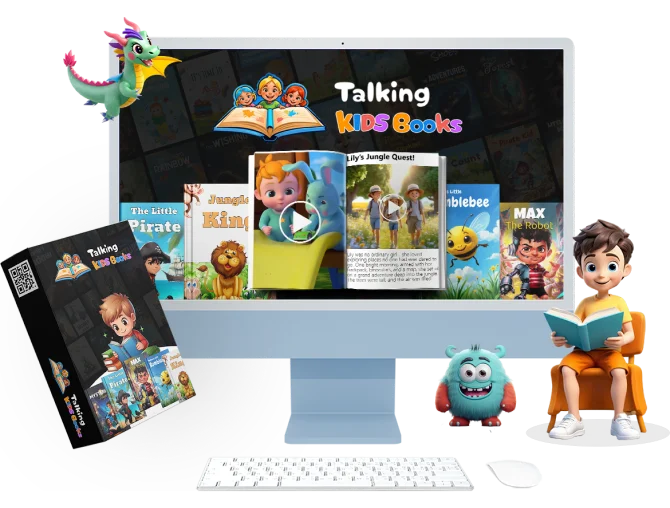It is worth highlighting that talking books for kids represent innovative solutions in the context of modern technologies, which define children’s learning, development, and communication processes. With their emphasis on utilising audio to add to print, these books are not only great learning tools to help children of all ages with literacy; they also ensure that children can enhance their imagination and ensure they are intrigued enough to want to keep reading. This essay acts as a discussion on talking books for kids, their uses, purposes, and drawbacks, focusing on their importance in current learning processes.

Talking Books Definition
Talking books can be described as regular texts that come with audio capabilities—mainly for reading. Such may include previous recordings of narrations, effects, and questions and answers. The narration can be received through in-built speakers, electronic applications, or dedicated devices. Talking books are, to be exact, books that are read to the child in addition to the images displayed on the pages, making reading a more auditory and visual event, completely appropriate for children of all ages or reading levels.
There are various formats of talking books, including:
Physical Talking Books:** These are such books as books with sound buttons or an audio pen in the form of a pen where children touch on text or picture to listen to a narration or to hear some particular sound.
Digital Talking Books:** that can be downloaded to e-readers or accessed with an app; these enable the reader to listen to the text and follow along as the app highlights the text in emphasis of what is being said.
Customized Audio Books:** Some apps allow the child to read on his or her own, while others will record a child’s voice or the voice of a close relative to read the story.
—
Why are talking books good for children?
The use of talking books gives a number of advantages in children’s learning, particularly in reading and language knowledge.
1. *Extended Literacy Development
By embedding the talking books in the classroom, students are also able to listen to correct pronunciation, intonation, and rhythm in language, thereby enhancing their reading speed. This lesson also sought to familiarize the students with some of the words that they are likely to come across while reading, and hearing as to how they are pronounced helps them a lot in capturing the phonetic aspect since young readers will be able to decipher what seems to be unfamiliar to them from what they are used to.
2. **Improved Comprehension**
Talking books help improve comprehensibility by combining audio with textual features of the visual text. Children can listen to the expression of sentences and read punctuation marks, so they are able to learn narrative patterns and other concepts.
3. *Building an Understanding for Literature
As much as talking books may benefit all users, children with reading difficulties or who dislike reading will find it easier to read. I noticed they pay attention to what is presented in terms of interactive and auditory features to make them read stories on their own.
4. **Dividing for the Various Needs of Learning Disability**
These addresses are for children with disabilities, including visual impairment or dyslexia. Audio description helps blind children to read books, and emphasised text helps children who have problems with reading.
5. **Listening Skills:**
Reading helps children develop MkLa (meaning, knowledge, and learning attention); listening helps to develop attention span and auditory learning. It also applies for academic and other social fields in which students should listen attentively and comprehend all information.
6. **: Issues of Cognitive and Emotional Development**
Talking books entail narratives, and in most of them, characters are easily illustrated characters with lessons to be taught. Immersing in these narratives may build children’s understanding of other people’s feelings, decision-making, and evaluation skills.

The uses of Talking Books
Talking books can be considered a multiple, useful tool in various educational and leisure activities for children.
1. **At Home**
Talking books can be employed by parents in the formal story telling, such as during bedtime story telling, or come up with time for independent reading when devices are prohibited. These books come in handy to parents, especially the busy ones, in that they help children read in moments when they lack supervision.
2. **In Classrooms**
Talking books are used in literacy activities because of differences in teaching strategies that favour talking books. All of these books can fit into group work, individual tasks, or be useful for ESL students.
3. **In Libraries**
Reading for visually impaired people is facilitated by talking books that are in libraries in the form of various formats, including apps. These resources are open for borrowing, meaning children from all kinds of homes can benefit from them.
4. **Therapeutic Settings**
Talking books are employed by speechech therapists and special education teachers for children with speech, language, and auditory processing delays or learning disabilities. As talking books entail involving the youth, they are more likely to be milestones in regard to the level of engagement and retention.
—
Frequently Used Styles And Some Sample Documents
There are many formats and products available, tailored to specific age groups and learning goals:
Interactive Picture Books:** These come with illustrations and applicable sounds, friendly for preschool children. For instance, there is the talking book edition of *The Very Hungry Caterpillar that reads and counts the story at the same time.
– **E-Books with Audio Synchronization:** Kindle, for instance, and the Audible app address older children, such that when the audio plays, the text synchronizes with it.
Customizable Talking Books:** Some of them can be *Tonies* or LeapFrog LeapReader—the devices that enable kids to listen to some stories already uploaded or record their ones, which can open the door to creativity.
—
Disadvantages of Speaking Books
While talking books offer numerous benefits, there are challenges to consider:
1. **Screen Dependence**
Digital talking books, apps, and arcades through screens aim at helping children with a disability, but the use of a screen may end up making the child spend much of their time on screen, thus exposing them to health complications and poor attention.
2. **Less Emphasis on Free Reading**
One significant hazard of using too much audio description may reduce a child’s desire to read on their own, or at least to read comprehensively on their own.
3. **Accessibility and Cost**
It has also been found that good talking books or specialized devices for the purpose may not be out of the price range for families or schools with budget constraints.
4. **Overstimulation**
In some cases, the inclusion of sound effects as well as aggressive narrating deters the child or children from the content of the story within the video.
—
Parent & Educators Tips
To maximize the benefits of talking books while addressing challenges, parents and educators can adopt thoughtful strategies:
Balance Audio and Reading:** To provide an opportunity for children’s multiple listening and repeated reading to build listening and reading competencies.
Limit Screen Time:** Ideally, get physical talking books or buy talking books that are developmental for children to reduce the impact of screen time.
Select Age-Appropriate Content:** Only select books appropriate for the child’s age, their interests, and reading ability to keep them interested.
Encourage Discussion:** When reading or listening to a story, the character, plot, and lessons of the story should be reviewed in order to enhance the flow of thinking among the learners.
—
The Future of Talking Books
New gadgets being developed are going to influence the talking books in the future. Interactive elements are expected to be extended with key characteristics such as artificial intelligence (AI) and augmented reality (AR). For example:
AI Narration:** Product narrators can be made to flexibly actually change their speaking velocity, use a slow and casual tone, or even switch to more complex language as per the child’s desire or capabilities in reading.
AR Integration:** When it comes to the standard of appearance, books that use AR devices and project 3D animations or interactive visuals can tell the story.
Multilingual Options:** Increasing the library of multilingual narrations can include children with various levels of proficiency in the language that is being used at school.
—
Conclusion
Children’s phonics books are not just the marriage of voice and text; they are means that help children learn to find fascination in reading. Together with education, they broaden the children’s awareness of the world of literature while entertaining them and adapting themselves to any child’s learning disability. Still, these difficulties do not remove the fact that talking books used in a proper and effective manner should be an integration into any child’s learning process. With further advancement in technology, the impact of talking books to educate, motivate, and inform young readers will automatically increase, making them one of the most formidable tools of childhood learning.